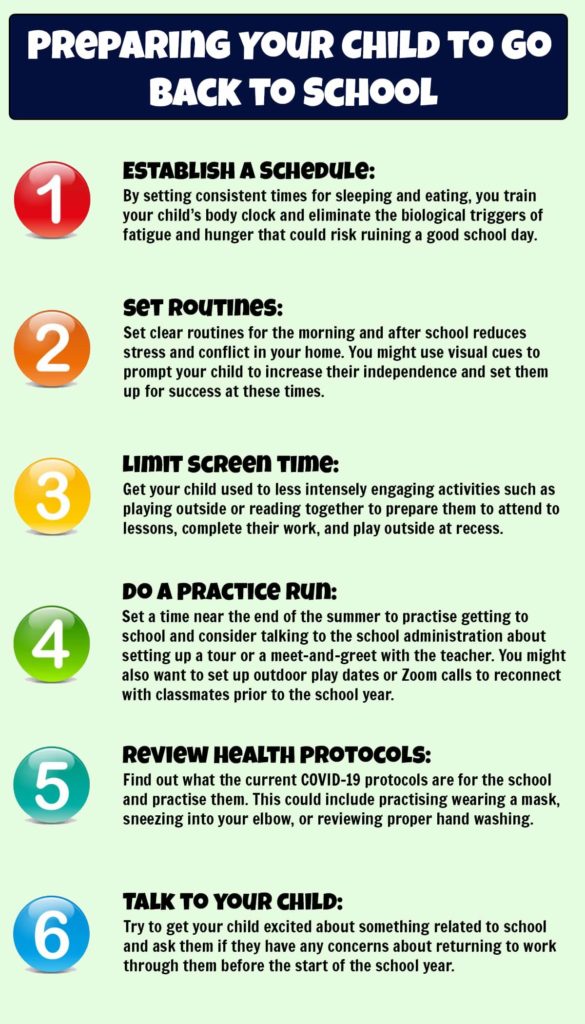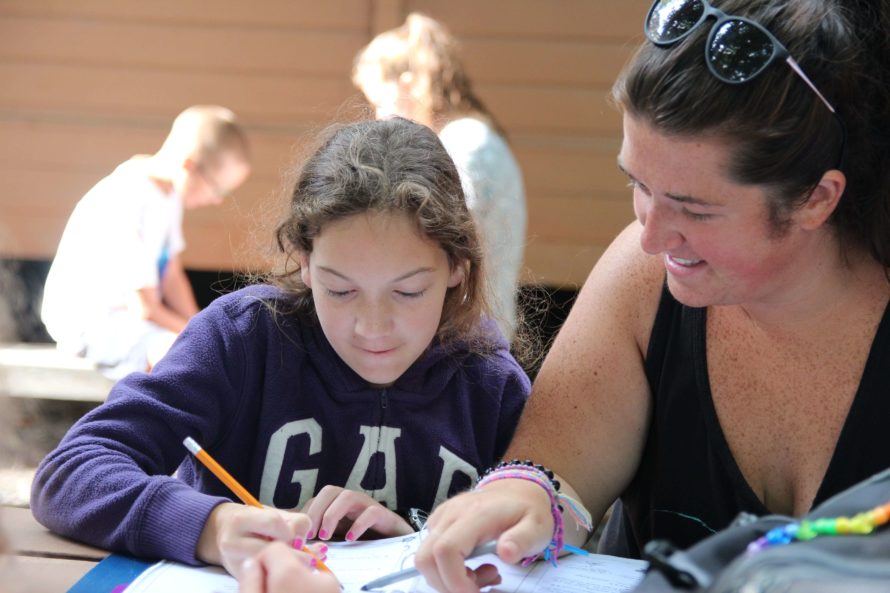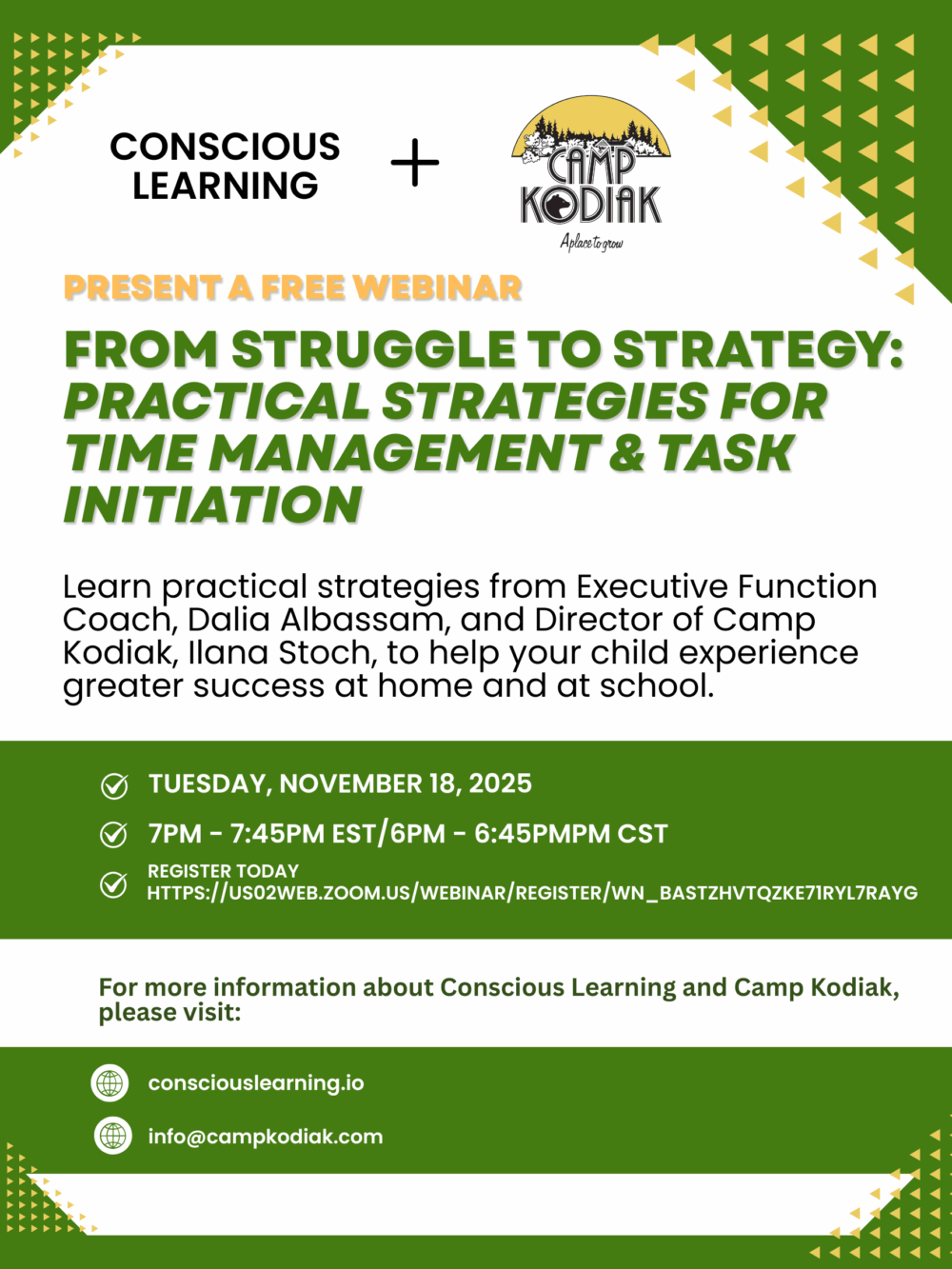Getting your child ready to go back to school at the end of the summer can be challenging at the best of times. And, after months of online learning, this year is bound to be even trickier. But what if I told you that there are ways of making back-to-school a little smoother? Have a look below for some pointers.
- Establish a regular (late summer) schedule
Summer is often a time of staying up late, sleeping in, and following a different schedule every day—for the kids, at least. What that means is that going back to school isn’t just going back to school; it’s a change to when they get up, when they eat, when they have to get dressed – everything. No wonder it’s so hard on them and you.
Upending their sleeping and eating without enough prep can also mean that fatigue and hunger might blow up what would otherwise have been a good day. So, a few weeks before the end of summer, start setting a regular weekday wake-up and/or bedtime, or set your mealtimes according to your school day schedule. You will be training your child’s body to be ready for the school schedule again and heading off those hunger and fatigue triggers.
Will they hate the change? Sure. But getting them into the rhythm now really will set them up for more success when the first day of school comes.
- Set those routines
Routines are the little details involved in following a schedule. Mornings, especially, need to have firm routines set up before kids head back to school. So we have to think of ways they can remember all the things they need to do in order to stay on schedule. For some kids, a visual schedule (like a list on the table or in the bathroom) can walk them through the steps of getting up, getting dressed, making their bed, eating breakfast, brushing their teeth, preparing their backpack, and any other tasks that need to be completed in the morning. It might seem unnecessary, but it helps to eliminate parent nagging (which benefits everybody) and encourages independence.
If their summer mornings have been loose and free (lucky them), getting back into a school day morning routine might be jarring. But getting them to practise their morning routine the week before school will help them get ready for the real thing.
After school is another time when routines might be helpful. Consider what you want accomplished in the afternoon. Should your child have a snack? Do homework? Walk the dog? Help with dinner? Again, having a visual cue can help them remember where to put their backpack, shoes, and lunch bag and can walk them through the tasks that they need to accomplish before dinner. Guiding, reminding, and helping them practise their routines are good ways to help them build success.
- Limit screen time for classroom success
So far, we have talked about setting our kids up for success with the transition of getting to school. But what about once they are there? How can we help them make the shift to the different kind of learning experiences that happen in school versus what they experience during the summer when they might be spending more time on their devices?
Game designers engineer content so that it keeps our kids engaged and coming back for more. But the way our kids are involved online isn’t the same way they will be engaged in the classroom. That’s just not how in-person learning happens. And we need to prepare them for that shift, too. Limiting the amount of time they spend on devices during the summer will help them make the shift to the different kind of engagement they are going to experience when they are back in the classroom.
- Do a practice run
If I have an important meeting at a place I have never been to before, I will sometimes drive the route several days before. It makes me feel less stressed, so I can focus on preparing for the meeting. And I think that our kids are no different.
Before school starts, help them practise how you’re going to get to school, whether it is familiarizing yourself with a bus stop, taking public transit, or doing a dry run of walking to the school building. Help them spot landmarks and review any safety procedures such as for crossing busy streets or riding a bus.
If your child is anxious about starting school, call ahead and ask if it might be possible to meet their teacher or have a tour of the building. Most school offices open at least a week before the first day for students, so you should be able to connect with a school administrator then.
Making the physical journey to the school as comfortable as possible is definitely a way of lowering first-day-of-school stress.
- Review COVID-19 protocols for school
This summer, it seems possible that lots of kids may have gotten out of the habit of wearing a mask or following protocols. It that’s true for your kids, they may need some practice getting comfortable with these protocols again.
Schools will be sending out information closer to the beginning of the school year about any COVID-19 protocols that will apply in September. Spending some time masked while watching television or playing a game can help them get used to the feeling again so that the transition to masking will be easier. If your child is resistant to masks, explore ones made of different materials, having different textures, or with different designs.
Getting them prepared ahead of time for whatever reality is happening in their school is a good way of making the shift to back-to-school easier.
- Talk to your child
We’ve talked a lot about things our kids may not be thrilled about when September comes: Routines, schedules, nerves around getting to the actual building. But what are they excited about? One of the ways we can ease the switch from summer to school is to help them remember the things they really like about the school experience.
So, find out what your child is looking forward to at school. Start rebuilding some of the social relationships that may have stalled during lockdown. You might be able to organize an outdoor play date or a Zoom call with classmates. Also find out if your child is worried or anxious about anything related to going back to school. Try to allay their fears by working through their concerns and/or mitigating any actual risks that exist.
The transition from summer to school can be a bumpy one. But hopefully you have found a few tips to make it a little bit easier. With some planning ahead, heading back to school can be a happy time for all.



